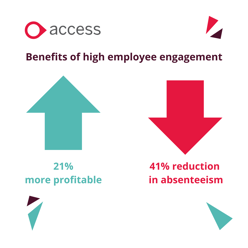The benefits of employee engagement and how to promote it in your organisation
The benefits of employee engagement can be significant, impacting productivity, innovation, customer satisfaction, and overall business success.
In today's competitive landscape, fostering workplace engagement is both important and beneficial. This post explores the benefits of employee engagement and why it can be so impactful in your organisation. We will also explore the challenges that organisations face with employee engagement and how you can tackle those.
In this article we will explore the following areas:
What is employee engagement?
Employee engagement goes beyond job satisfaction; it’s about the level of an employee’s emotional and mental connection to their work and their team. Much of that can be built through a promotion of a company culture and brand. The aim is to become an employer of choice; for more detail on what an employer of choice is and 7 ways to become one, read our blog. The emotional and mental connection with an organisation can have an impact on the commitment of your workforce.
Emotional Connection
This involves how employees feel about their work and the company. Do they feel valued? Are they passionate about their roles?
Mental Connection
This relates to how employees think about their work. Are they invested in the company's goals? Do they feel a sense of purpose?
Commitment
Engaged employees are committed to helping the organisation succeed. They are willing to go the extra mile and contribute their best efforts. Read more about how Employee Recognition Schemes can motivate employees to go that extra mile.
Why employee engagement matters to your organisation
Workplace engagement can serve as a powerful tool for several organisational outcomes. Better engagement across the whole workforce can impact your people strategies and business results. They can also facilitate an improved employee and customer experience as your organisational values reflect positively, both internally and externally.
Employee engagement is one of the leading indicators of organisational health as declining engagement can often lead to drops in productivity, quality issues, or increased staff turnover. Conversely, strengthening workplace engagement can have a positive influence on these issues.
The expectations of modern employees have evolved significantly. Candidates increasingly look for a meaningful and genuine connection to the organisation they apply for. Deloitte’s Gen Z and Millennial Survey notes that across 23,000 respondents, nearly all want purpose-driven work, and they are not afraid to turn down work that doesn’t align with their values. Understanding what your candidates are looking for is an important facet in attracting top talent in competitive markets. However, it’s not limited to just attracting talent. Your company brand will help you retain and develop teams, create authentic connections with clients, and build a culture of innovation.
What are the benefits of employee engagement?
Employee engagement certainly matters to an organisation, but business is results-driven. As such, the benefits need to be tangible and span the scope of the whole business. Importantly, they also need to deliver value. The benefits gained from workplace engagement include the following:
1. Enhanced performance and productivity
When employees feel engaged with their work, productivity tends to follow. A Gallup study indicates that companies with high employee engagement are 21% more profitable. Engaged employees regularly go beyond the minimum requirements. Higher staff motivation can also mean less distractions as the employees remain focused. Engaged teams can also find more effective ways to work, reducing the wasted time and resources. Gallup also noted that highly engaged workplaces see a 41% reduction in absenteeism. For other ways to reduce absenteeism, read our blog detailing ‘7 ways to reduce absenteeism’.
2. Improved retention and reduced turnover costs
Employees who feel valued and connected to their work are less likely to seek other employment. This reduces the costs associated with recruitment and training. Gallup's research highlights that 51% of currently employed workers globally are watching for or actively seeking a new job. When workplace engagement is higher for an extended period, team cohesion also grows, and employees are encouraged to stay with the business. With improved retention, onboarding and training costs also decrease.
3. Better customer experience
Engaged employees can provide better customer service. They may be more enthusiastic and passionate about their work, which translates into positive customer experiences.
4. Greater innovation and problem-solving
Workplace engagement can create a nurturing environment which can be conducive to innovation flourishing. Employees will think creatively about problems and be unafraid to fail, particularly with the advent of AI technology. New ideas that can benefit the organisation may also be trialed and implemented more quickly. Ultimately, this can lead to a culture of continuous learning and future proofing of the workforce. Future proofing and AI enablement are significant L&D trends in 2025, of which you can read more in our blog.
5. Stronger organisation
Employee engagement can strengthen organisational resilience. This becomes particularly valuable during industry disruptions or economic downturns. Engaged teams and motivated staff can support one another, maintain performance, and help you pivot strategically if required.
6. Enhanced employer brand and talent attraction
As your employer brand grows, your organisation becomes more attractive to high-quality candidates. Recruitment efforts can yield better results with less investment as even passive candidates may recognise the strength of your brand and look to apply to you first when ready. For other strategies to recruit passive candidates, read our ‘How to attract and recruit passive candidates’ blog.

7 common challenges that affect employee engagement
While the benefits of employee engagement are highly desirable, many organisations struggle to achieve and maintain high levels of workplace engagement. Understanding these common challenges and addressing them can help develop an environment where staff motivation flourishes.
1. Poor communication and transparency
Poor communication can be a significant barrier to engagement as information may not flow freely between systems or teams. Therefore, features like employee benefits may be lost in these information silos. Inconsistency in messaging can also impact the overall trust that employees have in the organisation.
Communicating information about employee benefits effectively can be particularly motivating for employees. The modern workforce looks for a remuneration package beyond salaries.
TFG London mastered this specific challenge by delivering a personalised employee benefits experience, using their platform to highlight the benefits that matter most to their large and diverse team.
2. Mismatching company values and practices
Feeding into a possible lack of trust is what the company advertises as their values and what they ultimately practice. If there’s a disconnect between them, employees may immediately feel disengaged. For example, commitments to promotion of a healthy work-life balance could be undermined by an expectation of being available all the time. Other examples that can lead to mistrust and disengagement can include a contradiction of diversity values.
To combat this challenge, your organisation needs to maintain authenticity and follow the values laid out.
3. Insufficient growth and development opportunities
Employees place a premium on building their careers in their meticulously chosen employers. Therefore, limited access to training, unclear career pathways, and unfair promotion systems can lead to further disengagement. An organisation can succeed when it presents a clear and engaging future to their employees.
4. Inadequate recognition and feedback
Without regular, authentic recognition, employees may question whether their contributions are valued or even noticed.
Learn how Reach PLC utilised their harmonised employee benefits and rewards platform with Access to deliver over £100,000 in rewards to overcome this specific challenge.
5. Leadership and management practices
As employees engage with their management day-to-day, poor practices like micromanagement and impersonal relationships can whittle away any engagement initiatives. These practices also extend to the wider team. Fostering a supportive and collaborative working environment also requires effective management practices. Without them, toxic behaviours can surface.
6. Workloads leading to burnout
Deeper engagement will often take time, and employees will dedicate extra energy to their tasks. Overloading employees or understaffing can lead to excessive workloads and ultimately burnout. Staff motivation is then severely affected.
7. Ineffective tools and technology
Outdated and siloed systems can make even the simplest tasks needlessly complicated. For example, disconnected system that require multiple instances of manual data entry can be a source of frustration.
For a fully customised quote please get in touch with us
How the right HR tools can improve employee engagement
The right digital solutions can address many of the barriers we've discussed while amplifying your engagement initiatives. Some of the HR tools that can aid your engagement strategy include:
- Employee Benefits Platforms - Harmonise your employee benefits under one central platform.
- Employee feedback surveys – Regular surveys providing real time feedback and data.
- Reward and recognition platforms – Encourage peer-to-peer recognition, building a culture of appreciation, and supplying employees with instant rewards.
- Learning Management Systems – Options to learn however and whenever employees want to, including blended learning; read more about this style of learning in our blog, ‘The benefits of blended learning’.
- Performance management – Frameworks for regular check-ins and structured, focused goal setting. Internal communications platforms – Company-wide messaging and content visibility to build trust and authenticity
- Employee wellbeing – Resource hubs, mindfulness programmes, and work-life balance features.
- HR and People Analytics – Real-time analytics identifying retention risks and engagement metrics
How PeopleXD Evo delivers the whole package
Boosting employee engagement is a persistent challenge, often hindered by fragmented systems and lack of easy access to information. However, implementing an AI-enabled and integrated HR suite like Access People XD Evo, offers a clear path forward. By unifying HR, payroll, learning, and benefits information into a single, user-friendly platform, organisations can significantly improve visibility and accessibility.
Features like intuitive employee self-service, accessible anytime and anywhere (including mobile), empower staff to explore, understand, and manage their career progression, training and benefits, alongside other essential employment details. Employee benefits can be a particularly potent tool to improve staff motivation; read our blog to see how to develop a successful rewards and recognition system.
Ultimately, the right HR suite transforms benefits engagement by integrating it into the daily flow of employee interaction, leveraging data for better insights, and fostering a more connected, informed, and engaged workforce.
Learn more with our HR and Payroll blogs
Our HR and payroll blogs offer advice and guidance from industry experts.

 AU & NZ
AU & NZ
 SG
SG
 MY
MY
 US
US
 IE
IE











